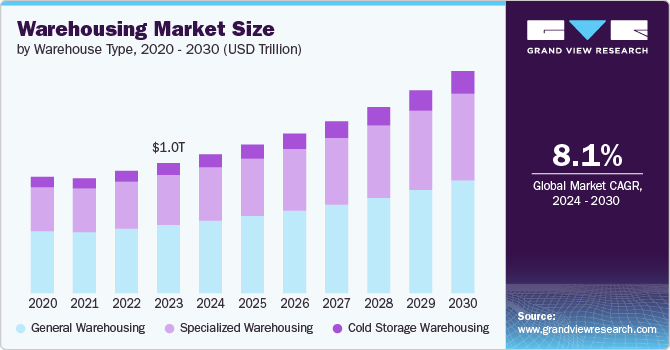Warehousing Market Size, Share & Trends Analysis growing at a CAGR of 8.1% from 2024 to 2030

The global warehousing market size was estimated at USD 1.01 trillion in 2023 and is projected to reach USD 1.73 trillion by 2030, growing at a CAGR of 8.1% from 2024 to 2030. Various factors, including e-commerce expansion and increasing globalization & supply chain complexity, drive the growth of the market.
Key Market Trends & Insights
- North America dominated the market with a market share of 31.0% in 2023.
- The market in the U.S. is projected to grow at a CAGR of 6.7% from 2024 to 2030.
- By warehouse type, the retail segment held the largest market share of 31.0% in 2023.
- By end-use, men’s workwear accounted for a revenue share of 87.3% in 2023.
- By end-use, the food & beverages segment is expected to register the fastest CAGR over the forecast period.
Market Size & Forecast
- 2023 Market Size: USD 1.01 Trillion
- 2030 Projected Market Size: USD 1.73 Trillion
- CAGR (2024-2030): 8.1%
- North America: Largest market in 2023
- Asia Pacific: Fastest growing market
Request a free sample copy or view report summary: https://www.grandviewresearch.com/industry-analysis/warehousing-market-report/request/rs1
Moreover, technological advancements in the sector offer significant growth opportunities for the market. Warehousing is a critical component of supply chain management, ensuring that inventory is managed efficiently and is readily available to meet demand. Inventory management, storage, and order fulfillment are some of the key aspects of warehousing.
Warehousing provides essential benefits that enhance operational efficiency, reduce costs, improve customer satisfaction, and support overall business growth. By optimizing storage, inventory management, and distribution processes, warehousing plays a vital role in the modern supply chain. The growing environmental concerns are prompting warehouse operators to adopt green practices. Modern warehouses often incorporate energy-efficient technologies and practices, reducing environmental impact. Moreover, implementing recycling and waste management practices within warehouses promotes sustainability.
E-commerce is driving the growth of the warehousing market by increasing the demand for storage space and accelerating the need for rapid order fulfillment. According to the U.S. Department of Commerce of the International Trade Administration (ITA), global Business-to-Business (B2B) e-commerce will reach a market value of over USD 36 trillion by 2026. E-commerce businesses need to maintain higher inventory levels to ensure product availability and meet rapid order fulfillment demands. This necessitates larger storage spaces. Moreover, consumers expect quick delivery times, sometimes within the same day. Warehouses close to urban centers are essential to meet these expectations.






